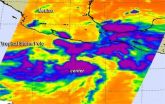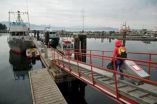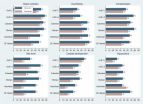(Press-News.org) Rice University scientists who created a deicing film for radar domes have now refined the technology to work as a transparent coating for glass.
The new work by Rice chemist James Tour and his colleagues could keep glass surfaces from windshields to skyscrapers free of ice and fog while retaining their transparency to radio frequencies (RF).
The technology was introduced this month in the American Chemical Society journal Applied Materials and Interfaces.
The material is made of graphene nanoribbons, atom-thick strips of carbon created by splitting nanotubes, a process also invented by the Tour lab. Whether sprayed, painted or spin-coated, the ribbons are transparent and conduct both heat and electricity.
Last year the Rice group created films of overlapping nanoribbons and polyurethane paint to melt ice on sensitive military radar domes, which need to be kept clear of ice to keep them at peak performance. The material would replace a bulky and energy-hungry metal oxide framework.
The graphene-infused paint worked well, Tour said, but where it was thickest, it would break down when exposed to high-powered radio signals. "At extremely high RF, the thicker portions were absorbing the signal," he said. "That caused degradation of the film. Those spots got so hot that they burned up."
The answer was to make the films more consistent. The new films are between 50 and 200 nanometers thick – a human hair is about 50,000 nanometers thick – and retain their ability to heat when a voltage is applied. The researchers were also able to preserve their transparency. The films are still useful for deicing applications but can be used to coat glass and plastic as well as radar domes and antennas.
In the previous process, the nanoribbons were mixed with polyurethane, but testing showed the graphene nanoribbons themselves formed an active network when applied directly to a surface. They were subsequently coated with a thin layer of polyurethane for protection. Samples were spread onto glass slides that were then iced. When voltage was applied to either side of the slide, the ice melted within minutes even when kept in a minus-20-degree Celsius environment, the researchers reported.
"One can now think of using these films in automobile glass as an invisible deicer, and even in skyscrapers," Tour said. "Glass skyscrapers could be kept free of fog and ice, but also be transparent to radio frequencies. It's really frustrating these days to find yourself in a building where your cellphone doesn't work. This could help alleviate that problem."
Tour noted future generations of long-range Wi-Fi may also benefit. "It's going to be important, as Wi-Fi becomes more ubiquitous, especially in cities. Signals can't get through anything that's metallic in nature, but these layers are so thin they won't have any trouble penetrating."
He said nanoribbon films also open a path toward embedding electronic circuits in glass that are both optically and RF transparent.
INFORMATION:
Rice graduate student Abdul-Rahman Raji is lead author of the paper. Co-authors are Rice graduate student Errol Samuel and researcher Sydney Salters, a student at Second Baptist School, Houston; Rice alumnus Yu Zhu, now an assistant professor at the University of Akron, Ohio; and Vladimir Volman, an engineer at Lockheed Martin. Tour is the T.T. and W.F. Chao Chair in Chemistry as well as a professor of materials science and nanoengineering and of computer science. He is a member of the Richard E. Smalley Institute for Nanoscale Science and Technology.
The Lockheed Martin Aerospace Co. through the LANCER IV Program, the Office of Naval Research's Multidisciplinary University Research Initiative and the Air Force Office of Scientific Research supported the research.
Read the abstract at http://pubs.acs.org/doi/abs/10.1021/am503478w
Follow Rice News and Media Relations via Twitter @RiceUNews
Related Materials:
Tour Group: http://www.jmtour.com
Images for download:
http://news.rice.edu/wp-content/uploads/2014/09/0916_GNR-graphic1-lg.jpg
CAPTION: Rice University's high-density graphene nanoribbon film are fabricated in a multistep process.
CREDIT: J.M. Tour/Rice University
http://news.rice.edu/wp-content/uploads/2014/09/0916_GNR-sem1-lg.jpg
CAPTION: This scanning electron microscope image shows the network of conductive nanoribbons in Rice University's high-density graphene nanoribbon film.
CREDIT: A.O. Raji/Rice University
http://news.rice.edu/wp-content/uploads/2014/09/0916_GNR-sem2-orig.jpg
CAPTION: This scanning electron microscope image shows a closeup of nanoribbon network in Rice University's high-density graphene nanoribbon film.
CREDIT: A.O. Raji/Rice University
http://news.rice.edu/wp-content/uploads/2014/09/0916_GNR-tour-lg.jpg
CAPTION: James Tour
CREDIT: Jeff Fitlow/Rice University
Nanoribbon film keeps glass ice-free
Rice University lab refines deicing film that allows radio frequencies to pass
2014-09-16
ELSE PRESS RELEASES FROM THIS DATE:
Journal of Clinical Psychiatry: Long-term benefit of NeuroStar TMS Therapy in depression
2014-09-16
Malvern, Pennsylvania, September 16, 2014 – Neuronetics, Inc., today announced that results of a study designed to assess the long-term effectiveness of NeuroStar TMS Therapy in adult patients with Major Depressive Disorder (MDD) who have failed to benefit from prior treatment with antidepressant medications, were published online in The Journal of Clinical Psychiatry. The study found that TMS treatment with the NeuroStar TMS Therapy System induced statistically and clinically meaningful response and remission in patients with treatment resistant MDD during the acute phase ...
NASA spots center of Typhoon Kalmaegi over Hainan Island, headed for Vietnam
2014-09-16
NASA's Aqua satellite saw Typhoon Kalmaegi's center near northern Hainan Island, China when it passed overhead on September 16 at 06:00 UTC (2 a.m. EDT). Hours later, the storm crossed the Gulf of Tonkin, the body of water that separates Hainan Island from Vietnam, and was making landfall there at 11:30 a.m. EDT.
The Moderate Resolution Imaging Spectroradiometer or MODIS instrument aboard Aqua captured a picture of the typhoon that shows the center near the northern end of Hainan Island, China, while the storm stretches over the mainland of southeastern China, east into ...
Computerized emotion detector
2014-09-16
Face recognition software measures various parameters in a mug shot, such as the distance between the person's eyes, the height from lip to top of their nose and various other metrics and then compares it with photos of people in the database that have been tagged with a given name. Now, research published in the International Journal of Computational Vision and Robotics looks to take that one step further in recognizing the emotion portrayed by a face.
Dev Drume Agrawal, Shiv Ram Dubey and Anand Singh Jalal of the GLA University, in Mathura, Uttar Pradesh, India, suggest ...
Newborn Tropical Storm Polo gives a NASA satellite a 'cold reception'
2014-09-16
The AIRS instrument aboard NASA's Aqua satellite uses infrared light to read cloud top temperatures in tropical cyclones. When Aqua passed over newborn Tropical Storm Polo off of Mexico's southwestern coast it got a "cold reception" when infrared data saw some very cold cloud top temperatures and strong storms within that hint at intensification.
Polo formed close enough to land to trigger a Tropical Storm Watch for the southwestern coast of Mexico. The watch was issued by the government of Mexico on September 16 and extends from Zihuatanejo to Cabo Corrientes, Mexico. ...
EARTH Magazine: The Bay Area's next 'big one could strike as a series of quakes
2014-09-16
Alexandria, Va. — Most people are familiar with the Great 1906 San Francisco Earthquake and are aware of the earthquake risk posed to the Bay Area — and much of California — by the San Andreas Fault. Most people are not aware, however, that a cluster of large earthquakes struck the San Andreas and quite a few nearby faults in the 17th and 18th centuries. That cluster, according to new research, released about the same amount of energy throughout the Bay Area as the 1906 quake. Thus, it appears that the accumulated stress on the region's faults could be released in a series ...
New research decodes virus-host interactions in ocean dead zones
2014-09-16
A complex web of interaction between viruses, bacteria, and their environment is becoming ever more untangled by a growing international collaboration between Matthew Sullivan, associate professor in the University of Arizona's Department of Ecology and Evolutionary Biology and Steven Hallam from the University of British Columbia in Vancouver, Canada.
"Bacteria are drivers of nutrient and energy cycles that power the earth," Sullivan said. "As the climate is changing, so are the environments these bacteria live in, and they in turn loop back to impact their environments. ...
New research shows tornadoes occurring earlier in 'Tornado Alley'
2014-09-16
BOZEMAN, Mont. -- Peak tornado activity in the central and southern Great Plains of the United States is occurring up to two weeks earlier than it did half a century ago, according to a new Montana State University study whose findings could help states in "Tornado Alley" better prepare for these violent storms.
Tornado records from Nebraska, Kansas, Oklahoma, and northern Texas – an area of high tornado activity dubbed "Tornado Alley" -- show that peak tornado activity is starting and ending earlier than it did 60 years ago.
Peak tornado activity, which occurs ...
Long-term results of RTOG 0236 confirm good primary tumor control, positive 5-year survival rates
2014-09-16
San Francisco, September 15, 2014—Patients with inoperable, early-stage lung cancer who receive stereotactic body radiation therapy (SBRT) have a five-year survival rate of 40 percent, according to research presented today at the American Society for Radiation Oncology's (ASTRO's) 56th Annual Meeting. Such a positive survival rate is encouraging considering that historically conventional RT resulted in poor tumor control for patients with inoperable lung cancer. This study is an update of RTOG 0236, originally published in 2010 , and also conducted by the original researchers ...
Politics divide coastal residents' views of environment, UNH research finds
2014-09-16
DURHAM, N.H. – From the salmon-rich waters of Southeast Alaska to the white sand beaches of Florida's Gulf Coast to Downeast Maine's lobster, lumber and tourist towns, coastal residents around the U.S. share a common characteristic: their views about coastal environments divide along political lines. That's a primary finding of a new study by University of New Hampshire sociologists published this month in the journal Society & Natural Resources.
"We found a lot of environment-related differences from place to place to place. Each environment is different so that's just ...
Artworks are people!
2014-09-16
Not all things are created equally. We don't view a Picasso sculpture in the same way we look at a hammer, for example — no matter how fancy the hammer.
The reason? We see the Picasso more as a person than an object, according to new research from the University of Chicago Booth School of Business.
And in some cases, we make distinctions between artworks — say, an exact replica of a piece created by the artist, versus one created by a different artist.
Art, in other words, is an extension of the creator, write Professor Daniel M. Bartels of Chicago Booth, and Professor ...
LAST 30 PRESS RELEASES:
University of Oklahoma researcher awarded funding to pursue AI-powered material design
Exploring how the visual system recovers following injury
Support for parents with infants at pediatric check-ups leads to better reading and math skills in elementary school
Kids’ behavioral health is a growing share of family health costs
Day & night: Cancer disrupts the brain’s natural rhythm
COVID-19 vaccination significantly reduces risk to pregnant women and baby
The role of vaccination in maternal and perinatal outcomes associated with COVID-19 in pregnancy
Mayo Clinic smartwatch system helps parents shorten and defuse children's severe tantrums early
Behavioral health spending spikes to 40% of all children’s health expenditures, nearly doubling in a decade
Digital cognitive behavioral treatment for generalized anxiety disorder
Expenditures for pediatric behavioral health care over time and estimated family financial burden
Air conditioning in nursing homes and mortality during extreme heat
The Alps to lose a record number of glaciers in the next decade
What makes a good proton conductor?
New science reporting guide published for journalists in Bulgaria
New international study reveals major survival gaps among children with cancer
New science reporting guide published for journalists in Turkey
Scientists develop a smarter mRNA therapy that knows which cells to target
Neuroanatomy-informed brain–machine hybrid intelligence for robust acoustic target detection
Eight SwRI hydrogen projects funded by ENERGYWERX
The Lundquist Institute and its start-up company Vitalex Biosciences Announces Strategic Advancement of Second-Generation fungal Vaccine VXV-01 through Phase 1 Trials under $40 Million Competitive Con
Fine particles in pollution are associated with early signs of autoimmune disease
Review article | Towards a Global Ground-Based Earth Observatory (GGBEO): Leveraging existing systems and networks
Penn and UMich create world’s smallest programmable, autonomous robots
Cleveland researchers launch first major study to address ‘hidden performance killer’ in athletes
To connect across politics, try saying what you oppose
Modulating key interaction prevents virus from entering cells
Project explores barriers to NHS career progression facing international medical graduates
Jeonbuk National University researchers explore the impact of different seasonings on the flavor perception of Doenjang soup
Two Keck Medicine of USC Hospitals named Leapfrog Top Teaching Hospitals
[Press-News.org] Nanoribbon film keeps glass ice-freeRice University lab refines deicing film that allows radio frequencies to pass



